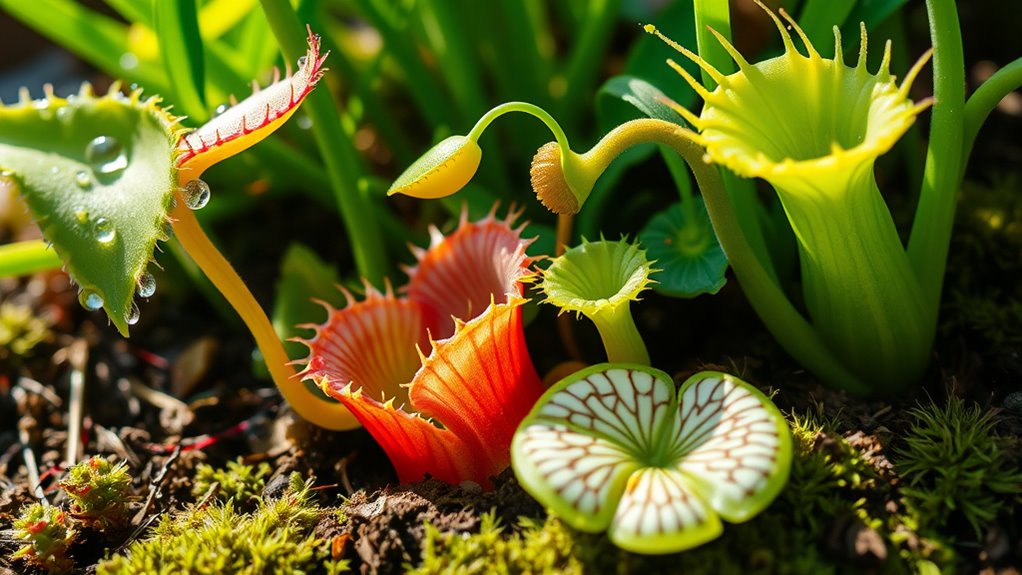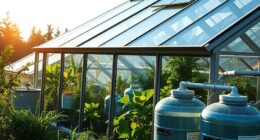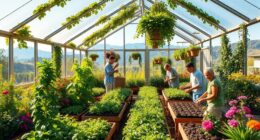If you’re looking to explore the fascinating world of carnivorous plants, I’d recommend starting with the Venus Flytrap, Sarracenia, and Nepenthes. These plants thrive in unique conditions and add a touch of intrigue to your collection. I’ve found that proper care, including the right soil mix and feeding schedule, makes all the difference. Plus, understanding their environmental needs guarantees their vibrant growth. Stick around, and you’ll discover more tips and tricks for cultivating these enchanting plants!
Key Takeaways
- Choose plants like Venus Flytrap and Pitcher Plants for their unique trapping mechanisms and adaptability to nutrient-poor soils.
- Ensure optimal growth conditions with bright, diffused light and a soil mix of sphagnum moss, peat, and perlite.
- Maintain high humidity and consistent moisture, adapting care routines based on specific species and local climate conditions.
- Monitor feeding needs closely, using live insects or specialized plant food while avoiding overfeeding to prevent trap decline.
- Consider growing from seeds for diverse options, but be prepared for varying germination times and the patience required for seedlings to mature.
The Curious World of Carnivorous Plants: A Comprehensive Guide
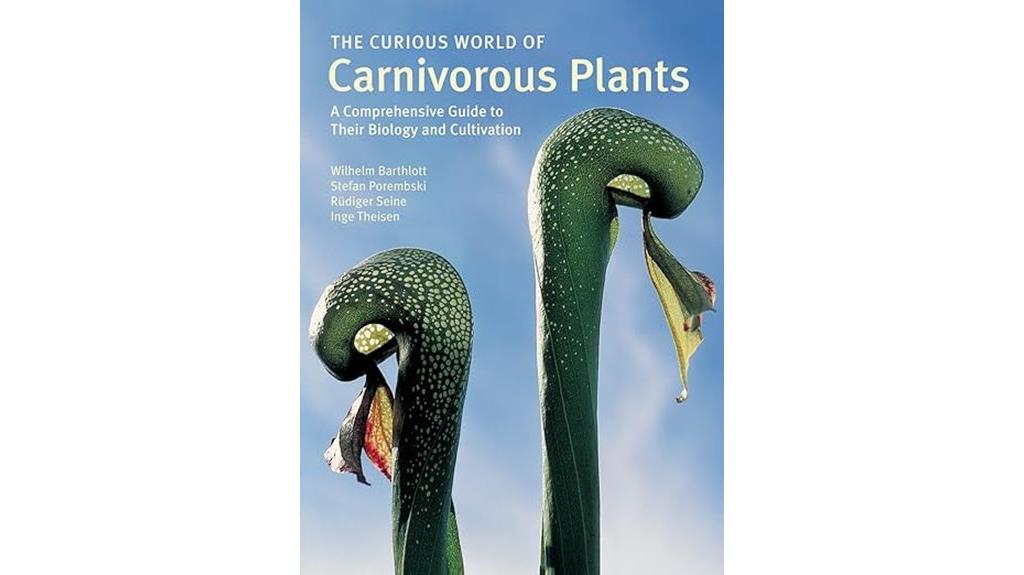
If you’re a plant enthusiast looking to expand your collection, “The Curious World of Carnivorous Plants” is an excellent choice for you. This all-encompassing guide covers everything from taxonomy to cultivation, making it a go-to resource. I love how it’s filled with stunning photographs and micro-photographs that really bring these unique plants to life. It dives into habitats, trapping mechanisms, and even the relationships between carnivorous plants and their prey. Whether you’re a novice or an expert, this book is approachable and informative, providing insights that enhance my understanding of these fascinating plants while avoiding overly complex jargon.
Best For: Plant enthusiasts of all levels who are interested in learning about carnivorous plants and their cultivation.
Pros:
- Provides comprehensive coverage of taxonomy, ecology, and physiology of carnivorous plants.
- Features stunning photographs and micro-photographs that enhance the reading experience.
- Accessible language makes it suitable for both novices and experienced gardeners.
Cons:
- Cultivation and propagation sections may not be as detailed as those found in “The Savage Garden.”
- Some readers may desire more technical botanical information.
- The extensive content may overwhelm those looking for quick reference.
Venus Flytrap Food, Solid Gel Carnivorous Plant Food (2.5OZ)
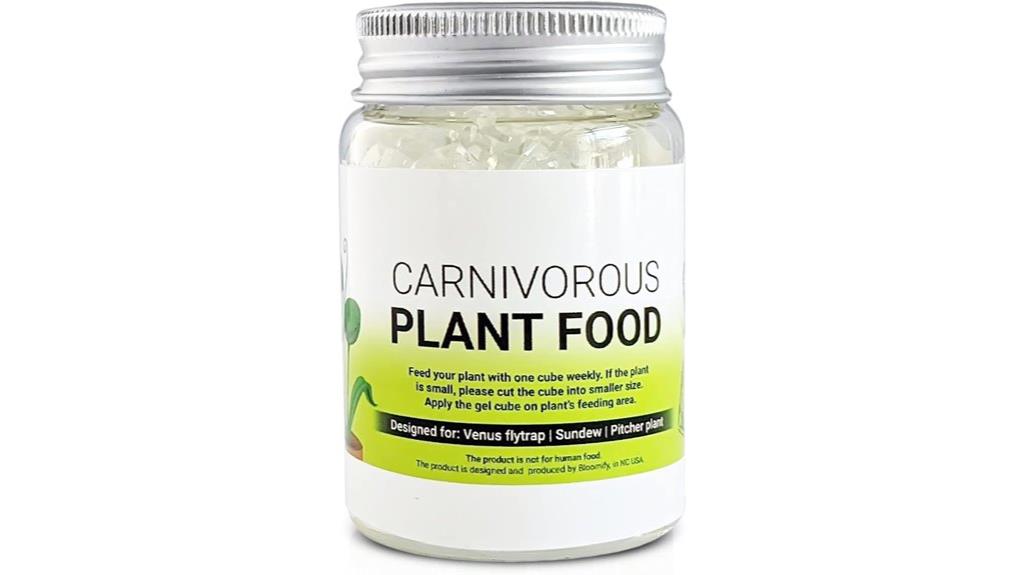
The Venus Flytrap Food, Solid Gel Carnivorous Plant Food (2.5OZ) stands out as an excellent choice for both novice and experienced plant enthusiasts looking to support their carnivorous plants’ growth effectively. This solid cube gel mimics real prey, giving your plants the natural stimulation they crave. It’s easy to digest, ensuring your plants receive essential vitamins and nutrients without the mess. I recommend feeding one gel cube weekly and cutting it for smaller plants. While most users rave about their plants thriving, I’d advise monitoring your plants for any adverse reactions to avoid overfeeding. Happy growing!
Best For: This product is best for both novice and experienced carnivorous plant enthusiasts looking to enhance their plants’ growth.
Pros:
- Solid gel mimics real prey, providing natural stimulation for plant growth.
- Easy to digest and mess-free solution, ensuring plants receive essential nutrients.
- Versatile use for various carnivorous plants, including Venus Flytrap, Sundew, and Pitcher Plants.
Cons:
- Some users report adverse effects such as wilting or traps turning black after feeding.
- Experiences vary widely, with some attributing issues to overfeeding or human error.
- New users may need to exercise caution and closely monitor plant responses.
New Carnivorous Plant seeds100pcs Generic

Looking to add some unique greenery to your indoor space? I recently discovered the New Carnivorous Plant seeds, and I couldn’t be more thrilled! With 100 seeds in each pack, you can cultivate these fascinating plants right from scratch. They’re packaged by Seed Needs, ensuring you get some of the freshest seeds available. The germination process is straightforward, and you’ll see results in just a few days if you follow the instructions. Plus, these plants help remove formaldehyde from your home. So, if you’re keen to grow something extraordinary, these seeds are a fantastic choice!
Best For: Indoor gardening enthusiasts looking to cultivate unique and low-maintenance plants.
Pros:
- Easy to grow: The seeds are suitable for beginners and have a very easy cultivation difficulty level.
- Air purification: These carnivorous plants help remove formaldehyde, improving indoor air quality.
- Fresh seeds: Packaged by Seed Needs, ensuring you receive some of the freshest seeds available for successful germination.
Cons:
- Seeds only: This product does not include live plants, which may not suit those seeking immediate greenery.
- Germination variability: Results may vary depending on the care and conditions provided during the germination process.
- Limited climate: Best suited for temperate climates, which may restrict growth in other environments.
Adult Sized Venus Flytrap (Dionaea Muscipula) Carnivorous Plant

For those enthusiastic to plunge into the world of carnivorous plants, the Adult Sized Venus Flytrap (Dionaea Muscipula) is a standout choice. This vibrant plant arrives in a 3-inch net pot, shipped bareroot with sphagnum moss. I appreciate the included caresheet and potting diagram from Joel’s Carnivorous Plants, making setup a breeze. It thrives in bright light, needing a bowl for distilled water, and prefers open air conditions. While it takes 2-3 years to grow to size, the health and packaging receive rave reviews. Just be ready for some research beyond the basics to guarantee your plant flourishes!
Best For: Those who are passionate about gardening and eager to nurture a unique carnivorous plant in their home or garden.
Pros:
- High-quality, live, and actively growing plant with clear care instructions included.
- Excellent packaging ensures the plant arrives healthy and ready for setup.
- Suitable for both indoor and outdoor settings, thriving in bright light conditions.
Cons:
- Requires patience, as it takes 2-3 years to reach a substantial size from seed.
- Some users may need additional research and care beyond the provided instructions for optimal growth.
- Experiences with plant longevity may vary, leading to potential challenges for beginners.
10pcs Butterwort Carnivorous Plant
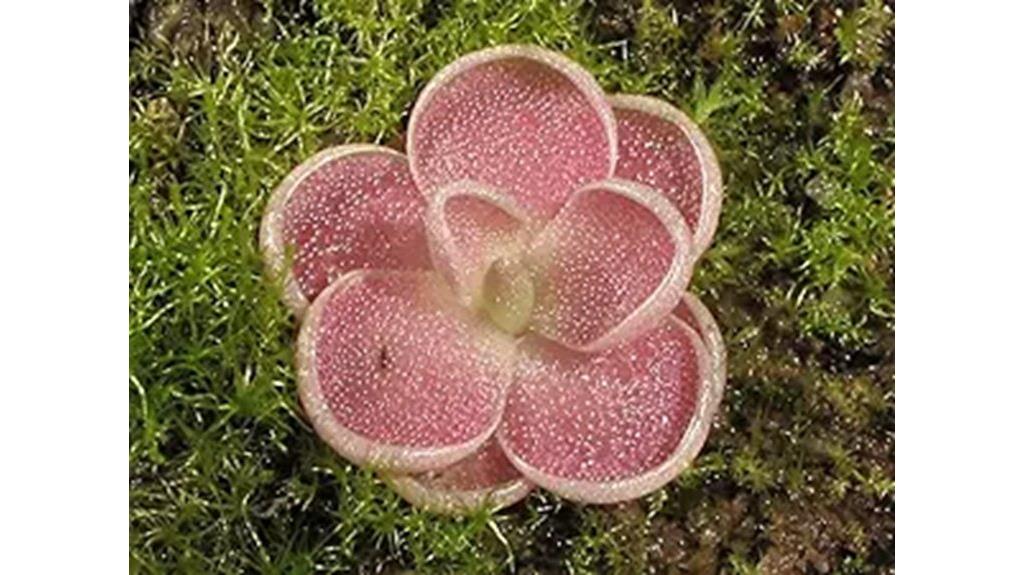
Ideal for budding gardeners and seasoned plant enthusiasts alike, the pcs Butterwort Carnivorous Plant offers an exciting opportunity to cultivate unique botanical specimens from seeds. I’ve found that these seeds can be tricky, requiring about six weeks to germinate, depending on soil and weather conditions. Many customers, including myself, initially expected live plants, leading to some disappointment. I recommend reading reviews before purchasing. While I faced challenges with germination and a lack of clear instructions, I remain hopeful. Despite high shipping costs and delays, the potential for growth keeps me invested in nurturing these fascinating plants.
Best For: Budding gardeners and seasoned plant enthusiasts looking for a unique challenge in growing carnivorous plants from seeds.
Pros:
- Offers an exciting opportunity to cultivate rare Butterwort Carnivorous Plants.
- Some customers reported receiving more than the advertised quantity of seeds.
- Potential for growth remains high, inspiring hope for future success.
Cons:
- Initial expectations of receiving live plants instead of seeds led to disappointment.
- Germination can be inconsistent, and some customers faced challenges despite being experienced gardeners.
- High shipping costs and delays created additional dissatisfaction among buyers.
Adult Sized Red Dragon Venus Flytrap Carnivorous Plant (3 inch Pot)

The Adult Sized Red Dragon Venus Flytrap, housed in a convenient 3-inch pot, stands out as a top choice for both novice and experienced plant enthusiasts. When it arrived bareroot with Sphagnum moss, I was impressed by the healthy condition and careful packaging. The included care sheet made potting straightforward, though I found some instructions a bit confusing. Many customers, including myself, enjoyed watching the plant thrive after following the guidelines. While some experienced health issues, overall, I recommend this seller for their quality and fast shipping. I might just repurchase another one for my collection!
Best For: Those looking to add an eye-catching, carnivorous plant to their collection, whether they’re beginners or seasoned plant lovers.
Pros:
- Well-packaged for safe transit, minimizing damage upon arrival.
- Healthy condition of the plant noted by many customers, leading to successful growth.
- Detailed care instructions provided, helping to guide new owners in potting and maintenance.
Cons:
- Some customers found the potting instructions confusing, leading to uncertainty in care.
- Mixed reviews regarding plant health post-purchase, with some experiencing decline.
- A few customers reported varying success with the plant’s vitality despite following care guidelines.
St. Gaya Pitcher Plant – Carnivorous Nepenthes by Wellspring Gardens
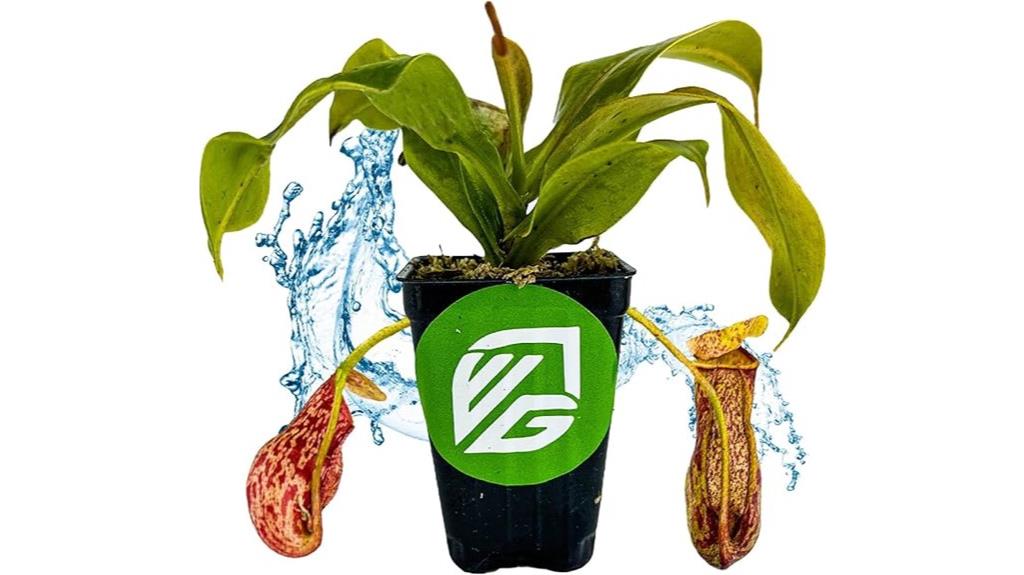
If you’re searching for an enchanting addition to your plant collection, the St. Gaya Pitcher Plant is a must-have. This carnivorous Nepenthes boasts striking pitchers and can reach around 18 inches in height. I love that it thrives in USDA Zones 10-12, making it versatile for indoor settings. With the right care—bright, diffused light and a peat/perlite mix—this plant flourishes beautifully. I’ve noticed it acclimates quickly and produces impressive pitchers as it matures. Just remember to monitor for pests and use distilled water to keep it healthy. It’s perfect for both beginners and experienced enthusiasts!
Best For: The St. Gaya Pitcher Plant is best for both beginner plant enthusiasts and experienced gardeners looking to add a unique carnivorous plant to their collection.
Pros:
- Thrives in bright, diffused light and requires consistent moisture, making it relatively easy to care for.
- Produces striking and impressive pitchers as it matures, adding visual appeal to any indoor space.
- Quick acclimation reported by many customers, leading to successful growth shortly after purchase.
Cons:
- Some customers have experienced health issues upon arrival, including pest infestations.
- Requires specific soil composition and care, which may necessitate additional research for new owners.
- Not suitable for colder climates unless proper care is taken for lowland or highland varieties.
Large Sized Live Giant Venus Flytrap (Dionaea) in Pot
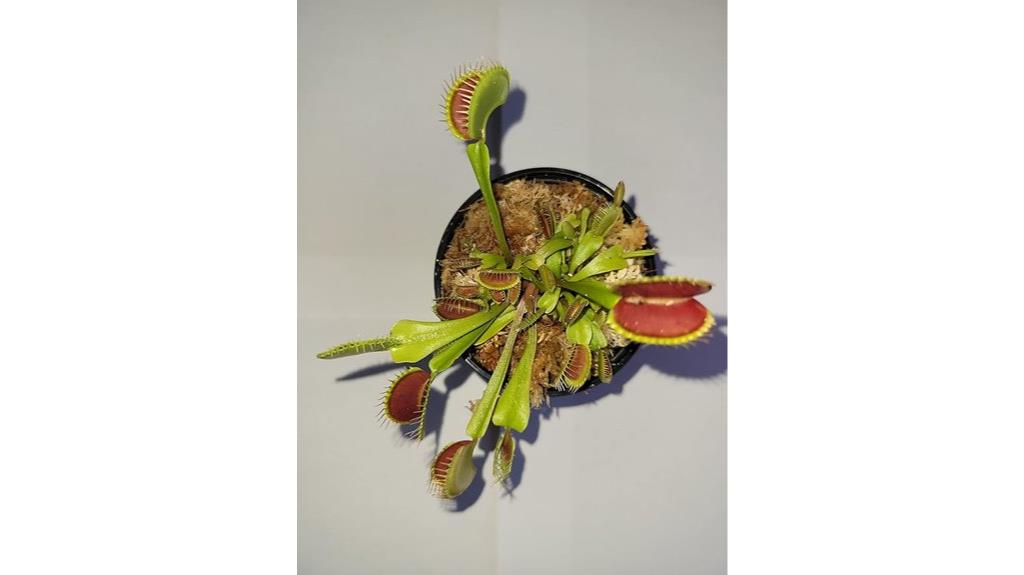
For those seeking an enchanting addition to their plant collection, the Large Sized Live Giant Venus Flytrap (Dionaea) in a 3-inch pot stands out. It arrives healthy and actively growing, ready to capture attention—and insects! Shipped bareroot with loose sphagnum moss, it’s perfect for carnivorous plant soil. I appreciate the detailed care sheet and potting diagram crafted by Joel, the seller. Many customers rave about prompt shipping and the plant’s quality. While some may initially experience slow growth, the excitement of watching traps spring to life is worth it. Just remember to use rainwater for ideal care!
Best For: Plant enthusiasts and families looking for a unique and educational addition to their collection.
Pros:
- Healthy and actively growing upon arrival, ensuring a vibrant addition to your plant collection.
- Detailed care instructions provided by the seller, helping you successfully maintain the plant.
- Positive customer feedback regarding shipping speed and plant quality, indicating reliability.
Cons:
- Mixed experiences with plant longevity, as some customers reported plants not surviving beyond a week.
- Initial slow growth may lead to impatience for some buyers eager to see results.
- Complex care instructions may be overwhelming for those new to carnivorous plants.
New Fresh 200pcs Scarlet Sarracenia Seeds Carnivorous Plant Generic

Looking to cultivate a striking addition to your garden? The New Fresh 200pcs Scarlet Sarracenia Seeds are an excellent choice! These seeds, packaged by Seed Needs, promise high quality and vigorous germination. I love that they come from a temperature-controlled facility, ensuring freshness. You won’t receive live plants, but the potential for stunning mature specimens is worth the wait. With proper care, you’ll see results in just days. If you ever face issues, their commitment to customer satisfaction means you can reach out for help. Grab these seeds and start your exciting carnivorous plant journey today!
Best For: Gardeners and plant enthusiasts looking to grow unique carnivorous plants from seeds.
Pros:
- High-quality seeds sourced directly from growers, ensuring freshness and viability.
- Vigorous germination with visible results in just days when sown correctly.
- Customer satisfaction commitment, providing support if any issues arise.
Cons:
- No live plants included, requiring patience for seedlings to mature.
- Requires specific care to ensure successful growth of carnivorous plants.
- Dependent on proper sowing techniques, which may be challenging for novice gardeners.
Large Size King Henry Giant Venus Flytrap Carnivorous Plant
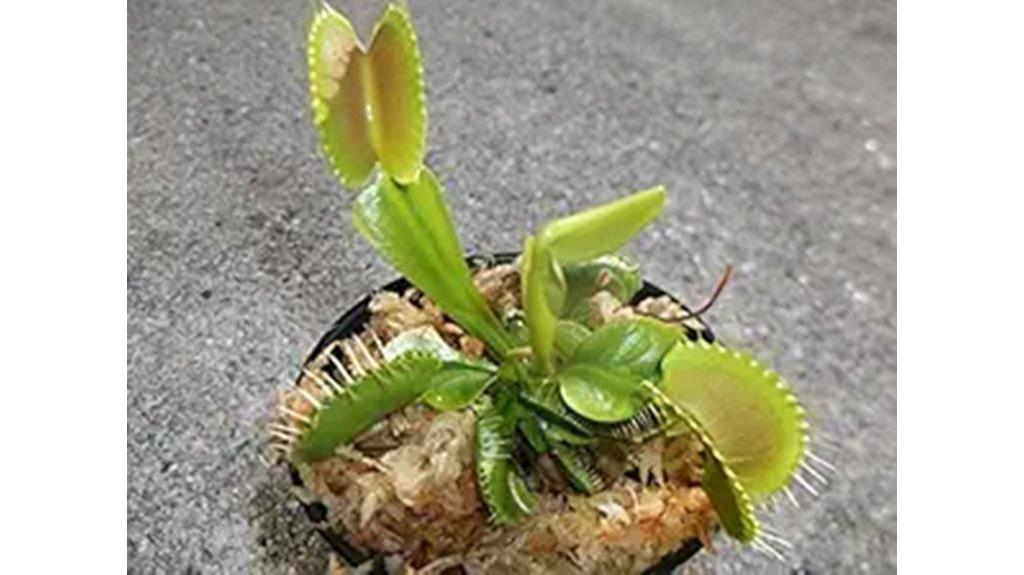
The Large Size King Henry Giant Venus Flytrap is an exceptional choice for both novice and experienced plant enthusiasts keen to cultivate a striking carnivorous plant. I love that it arrives bareroot with New Zealand Sphagnum moss, making potting straightforward. Many customers, including myself, noticed rapid growth and fly-catching shortly after planting. Just remember to use distilled water and give it plenty of sunlight. While some may find the care a bit demanding, the rewards are worth it. With a detailed care sheet included, you’ll be well-prepared to nurture this fascinating plant and watch it thrive in your collection.
Best For: The Large Size King Henry Giant Venus Flytrap is best for both novice and experienced plant enthusiasts looking to add a unique carnivorous plant to their collection.
Pros:
- Shipped bareroot with New Zealand Sphagnum moss for easy potting.
- Many customers report rapid growth and successful fly-catching shortly after arrival.
- Detailed care sheet included, helping owners provide proper care.
Cons:
- Some users find the care requirements more demanding than anticipated.
- Difficulty in sourcing insects for feeding may lead to dissatisfaction for some buyers.
- A few customers experienced plant health issues shortly after delivery.
Factors to Consider When Choosing Carnivorous Plant Production

When I choose carnivorous plants for production, I focus on several key factors that can make or break their success. It’s vital to take into account the type of plant, the specific growing conditions they need, and their feeding requirements. Additionally, I pay attention to soil composition and effective pest management strategies to guarantee healthy growth.
Plant Type Selection
How do you choose the right carnivorous plant for your setup? First, consider the specific habitat requirements. Some species thrive in wet, swampy environments, while others prefer drier conditions. Next, think about the trapping mechanisms; Venus flytraps use snap traps, whereas pitcher plants employ pitfall traps. This affects their care and feeding needs. The growth rate is another factor; some plants take years to mature from seed, while others grow quickly. Climate compatibility is essential too—Nepenthes love warm, humid environments, while Sarracenia can handle cooler temperatures. Finally, evaluate the level of care needed. If you’re a novice, choosing easier-to-cultivate species will set you up for success. Make these considerations, and you’ll find the perfect plant for you!
Growing Conditions Requirements
Selecting the right carnivorous plant goes beyond just the type; understanding their growing conditions is essential for successful cultivation. Most of these fascinating plants thrive in nutrient-poor, acidic soils, often made up of peat, perlite, or sphagnum moss. I’ve found that they generally need bright, indirect light, though some varieties require full sunlight. It’s important to water them with distilled or rainwater, as tap water can harm them; they prefer consistently moist conditions. Humidity also plays a role—tropical varieties enjoy high humidity, but many can adapt to drier environments. Finally, temperature needs vary, so selecting plants that match your climate is critical for thriving growth. Pay attention to these factors, and you’ll set your plants up for success.
Feeding Needs Assessment
Understanding the feeding needs of carnivorous plants is vital for their successful growth and health. Each species has unique requirements, so I assess their needs based on their specific type and growth stage. Generally, I find that feeding them small live insects or specialized plant food once a week works well. However, I keep an eye on their response; some plants may need more frequent feeding when they’re actively growing or producing new traps. It’s important to avoid overfeeding, as this can lead to trap decline or wilting. Additionally, I consider environmental factors like light, humidity, and temperature, as these will influence how much and how often I feed my plants to guarantee they thrive.
Soil Composition Importance
While I’ve learned that many factors contribute to the successful growth of carnivorous plants, soil composition stands out as one of the most critical elements. These unique plants thrive in nutrient-poor environments, so I mix sphagnum moss, peat, and perlite for ideal drainage and aeration while retaining moisture. It is crucial to maintain an acidic pH, ideally between 4.5 and 6.5, to mimic their natural habitats. I always avoid fertilizers and additives, as these can harm the plants; they rely on their prey for nutrients. A proper soil mix supports their unique root structures, preventing root rot while allowing efficient water absorption. Finally, I use distilled or rainwater to keep the soil healthy and mineral-free.
Pest Management Strategies
Good soil composition sets the stage for healthy carnivorous plants, but managing pests is just as vital for their thriving growth. I’ve found that implementing biocontrol strategies using these plants can effectively reduce pest populations in greenhouses and ponds. Regularly monitoring pest levels lets me adjust care practices for ideal health. I also like to integrate diverse plant species, as different carnivorous plants target specific insects, enhancing overall pest management. It’s essential to take into account environmental conditions like humidity and light, since they influence the plants’ growth and trap functionality. Finally, understanding the life cycles of both my carnivorous plants and pests helps me time interventions, ensuring my plants are most effective when pests peak.
Light Exposure Levels
Light exposure is essential for the success of carnivorous plants, and I’ve learned that getting it right can make all the difference. Most species thrive in bright, indirect light, mimicking their natural habitats like bogs and wetlands. I’ve found that providing at least 12 hours of light daily boosts growth and health. Too little light leads to etiolation, causing spindly growth, while too much direct sunlight can scorch leaves. It’s vital to take into account each species’ needs; for example, Nepenthes prefer shadier conditions than sun-loving Venus Flytraps. If you’re growing indoors, using full-spectrum grow lights can guarantee they receive the right wavelengths for peak photosynthesis, setting the stage for vibrant, thriving plants.
Frequently Asked Questions
How Do I Propagate Carnivorous Plants From Cuttings?
I’ve found that propagating carnivorous plants from cuttings can be a rewarding experience. First, I take a healthy cutting, ensuring it has a few leaves and part of the stem. Then, I dip the cut end in rooting hormone to encourage growth. I plant it in a suitable medium, like sphagnum moss or peat, and keep it humid. With patience, I usually see new growth in a few weeks. It’s truly exciting!
What Pests Commonly Affect Carnivorous Plants?
I’ve noticed a few pests that commonly affect carnivorous plants. Aphids and spider mites are the usual suspects, and they can really damage your plants if you’re not careful. I’ve also dealt with fungus gnats, which love the moist environment. To keep these pests at bay, I regularly check my plants and use insecticidal soap when needed. Staying vigilant has helped my plants thrive and stay healthy!
Can I Grow Carnivorous Plants Indoors Year-Round?
Absolutely, I’ve grown carnivorous plants indoors year-round with great success! It’s all about providing the right conditions. I make sure they get plenty of bright, indirect light, and I maintain humidity levels to mimic their natural habitats. I also use the right type of soil and water them with distilled water. With a little effort, my indoor plants thrive, and I love watching them catch pests!
What Is the Ideal Humidity Level for These Plants?
Did you know that many carnivorous plants thrive in humidity levels of 50% to 70%? I’ve found that maintaining this humidity is essential for their growth and health. If you’re growing them indoors, using a humidity tray or a humidifier can really help. I’ve had great success with my plants by monitoring the humidity closely and adjusting when needed. Keeping them happy means they’ll reward you with impressive traps!
Are There Any Companion Plants Suitable for Carnivorous Plants?
I’ve found that certain companion plants can thrive alongside carnivorous plants. For instance, I like to pair them with moisture-loving species like certain ferns or mosses. They not only complement the humidity needs but also create a beautiful, lush habitat. Just make sure these companions won’t compete for nutrients or light. It’s fascinating to see how these plants can coexist, enhancing the overall aesthetic and health of my green space!
Conclusion
In summary, cultivating carnivorous plants can be a fascinating journey for any enthusiast. Did you know that the Venus Flytrap can snap shut in just one-tenth of a second? That rapid movement is just one of the many wonders these plants offer. By choosing the right species and providing the proper care, you can create a thriving environment for these unique plants. So, why not plunge into and let your fascination with these incredible organisms grow?
